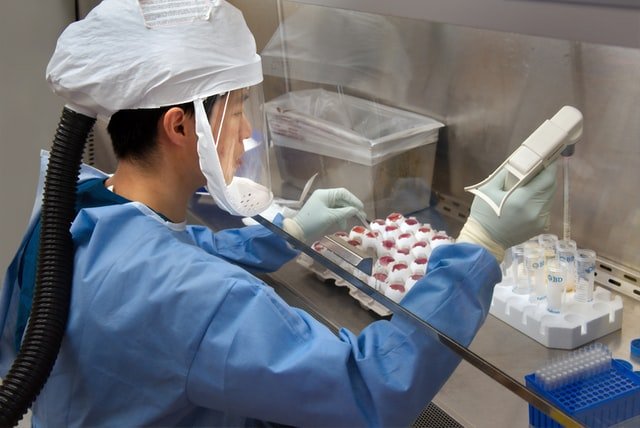Ovarian Cancer
- Biotexus
- April 14, 2025
About the ovaries
The ovaries are part of the female reproductive system. There are two ovaries, one on each side of the uterus. These glands are almond-shaped and around 1.5 inches long before menopause. They contain eggs, which are also known as germ cells. The ovaries are the body’s principal source of estrogen and progesterone. These hormones have an impact on breast development, body form, body hair, and the menstrual cycle and pregnancy. The ovaries stop releasing eggs and produce specific hormones during and after menopause.
About the fallopian tubes
The fallopian tubes are a series of tiny ducts that link the ovaries to the uterus. They are an essential component of the female reproductive system. The female reproductive system typically has two fallopian tubes, one on each side of the uterus. During monthly ovulation, an egg is normally released from one ovary and goes to the uterus via a fallopian tube.
About the peritoneum
The peritoneum is a tissue that borders the abdomen and most of its organs. The tissue encompasses the uterus, bladder, rectum, ovaries, and fallopian tubes. The omentum is a flap of this tissue that surrounds and links the organs in the belly. Peritoneal fluid coats the surface of the tissue. This liquid aids in the movement of the organs within the abdomen and prevents them from sticking together.
About ovarian, fallopian tube, and peritoneal cancers
The phrase “ovarian cancer” refers to tumors that start in the cells of the ovary, fallopian tube, or peritoneum. The cancers are linked and are typically treated in the same manner.
Because peritoneal cancer is uncommon, this category of tumors is referred to as “ovarian/fallopian tube cancer” in this guide. Because it is uncertain where the disease began, the phrase “ovarian cancer” encompasses both fallopian tube and peritoneal malignancies.
Certain cancers arise when healthy cells in these places alter and expand uncontrollably, generating a lump known as a tumor. A tumor might be malignant or benign.
An ovarian cyst is a benign development of tissue on the surface of the ovary. It can happen during a regular menstrual cycle and normally goes away on its own. Simple ovarian cysts do not cause cancer.
Types of ovarian and fallopian tube cancer
Epithelial carcinoma. Epithelial carcinoma accounts for 85–90% of ovarian/fallopian tube malignancies. Serous, endometrioid, clear cell, mucinous, mixed tumors, and many uncommon malignancies, such as Brenner tumors, are the most common forms of epithelial tumors.
Germ cell malignancies. This unusual kind of ovarian cancer arises in the ovaries’ egg-producing cells. Germ cell malignancies are most common between the ages of 10 and 29.
Sex cord stromal tumors. This rare kind of ovarian tumor arises in the connective tissue cells that keep the ovaries together, known as granulosa and theca cells.
Fallopian tube cancer. This disease was long assumed to be uncommon, but we now know that the majority of tumors previously called “ovarian cancer” originated in the fallopian tube.
Risk Factors
The following factors may raise a person’s risk of developing ovarian/fallopian tube cancer.
Family history. A person is more likely to develop ovarian/fallopian tube cancer if they have a strong family history of breast or ovarian/fallopian tube cancer. Doctors believe this is due to genetic abnormalities, or alterations in a gene, that are handed down from generation to generation in many of these families.
Genetics. A genetic abnormality that has been passed down through a family is responsible for 10% to 20% of ovarian/fallopian tube malignancies. This hereditary risk is referred to as a germline mutation. The American Society of Clinical Oncology (ASCO) recommends that all persons diagnosed with epithelial carcinoma, the most frequent kind of ovarian/fallopian tube cancer, undergo genetic testing for numerous cancer risk genes at the time of diagnosis.
There are several genetic conditions that can cause ovarian/fallopian tube cancer, including:
- Lynch syndrome. Lynch syndrome, also known as hereditary non-polyposis colorectal cancer, raises one’s chances of developing ovarian/fallopian tube cancer and uterine cancer. Mutations in numerous distinct genes cause it.
- Peutz-Jeghers syndrome (PJS). A unique genetic mutation causes PJS. Multiple polyps in the digestive tract that develop into noncancerous tumors are related with the disease, as is increased pigmentation (dark patches on the skin) on the face and hands.
- Nevoid basal cell carcinoma syndrome (NBCCS). People with NBCCS, also known as Gorlin syndrome, are more likely to develop fibromas. Fibromas are fibrous tumors of the ovaries that are benign. There is a slight chance that these fibromas will progress to fibrosarcoma, a kind of ovarian cancer.
- Li-Fraumeni syndrome and ataxia-telangiectasia. People who have Li-Fraumeni syndrome or ataxia-telangiectasia may be at a slightly higher risk of getting ovarian cancer.
Age. With age, the chance of acquiring ovarian/fallopian tube cancer rises. While these malignancies can be diagnosed at any age, persons over the age of 50 are more prone to acquire them. Approximately half of individuals diagnosed with ovarian/fallopian tube cancer are 63 or older.
Weight. Recent research suggests that those who were obese as adolescents, but not those who gained weight later in life, may be at a higher risk of getting ovarian/fallopian tube cancer. Obese people are more likely to die from any disease, including ovarian/fallopian tube cancer.
Endometriosis. Endometriosis occurs when the uterine lining develops outside of the uterus, affecting other surrounding organs. This illness can create a number of issues, but there is effective therapy available.
Ethnicity. Ovarian cancer is more common in those of North American, Northern European, or Ashkenazi Jewish ancestry.
History of reproduction. A person is more likely to get ovarian/fallopian tube cancer if they:
Menstruation began substantially earlier than the usual age of roughly 12 years.
Never given birth to a kid
Have unexplained infertility (the medical inability to have a child)
Have not used birth control pills
Menopause began substantially later than the average age of 51.
Replacement hormone treatment. After menopause, women who used estrogen-only hormone replacement treatment (HRT) may be at an increased risk of ovarian/fallopian tube cancer. The danger increases if the therapy is utilized for a longer period of time. After the therapy is completed, the risk diminishes over time.
Symptoms
The following symptoms or indicators may be experienced by those who have ovarian/fallopian tube cancer.
- Abdominal bloating
- Pelvic or abdominal pain
- Difficulty eating or feeling full quickly
- Urinary symptoms, such as urgency or frequency
- Fatigue
- Upset stomach
- Indigestion
- Back pain
- Pain during sexual intercourse
- Constipation
- Menstrual irregularities
- Swelling in the pelvis or abdomen
- Vaginal discharge, which may be clear, white, or tinged with blood
Treatment
The common types of treatments used for ovarian/fallopian tube cancer are described below.
Surgery
For certain forms of cancer, surgery is a crucial treatment option.
Surgery is frequently required to determine the full degree of the condition. The objective is to deliver a precise stage. Minimally invasive surgery is frequently utilized to confirm a diagnosis and to assess if a debulking technique should be performed at the time of diagnosis or after chemotherapy.
When patients with ovarian cancer have a debulking operation, the surgery will also include a staging technique that may entail the removal of several tissues, including lymph nodes, to determine if the disease has spread.
For ovarian/fallopian tube cancer, there are numerous surgical options. The sort of surgery recommended is determined on the stage of the tumor. During the same operation, surgeons may do two or more procedures:
Salpingo-oophorectomy. The ovaries and fallopian tubes are removed during this procedure. A bilateral salpingo-oophorectomy is performed when both ovaries and fallopian tubes are removed. If the patient wishes to have children in the future and has early-stage cancer, it may be feasible to remove only one ovary and one fallopian tube if the disease is only in one ovary. This procedure is known as a unilateral salpingo-oophorectomy.
Lymphadenectomy/lymph node dissection. The surgeon may remove lymph nodes in the pelvic and paraortic regions during this treatment.
Omentectomy. This procedure involves removing the thin tissue that covers the stomach and intestines.
Cytoreductive/debulking surgery. This operation is performed on patients who have advanced ovarian/fallopian tube cancer. The objective of cytoreductive surgery is to remove as much tumor as possible while remaining safe. Tissue from surrounding organs, such as the spleen, liver, and a portion of the small intestine or colon, may be removed. This may include removing a portion of each of these organs. This treatment can help alleviate symptoms by removing tumors that may be pushing on other organs. It may improve the efficacy of other treatments provided following surgery.
Therapies using medication
Medication to eliminate cancer cells may be part of the therapy approach. Medication can be delivered through the circulation to cancer cells all throughout the body. Systemic treatment refers to the administration of a medicine in this manner. Medication can also be administered locally, which means that it is delivered directly to the malignancy or is retained in a certain portion of the body.
The types of medications used for ovarian, fallopian tube, and peritoneal cancer include:
- Chemotherapy
- Targeted therapy
- Immunotherapy
- Hormone therapy (in rare cases)
Chemotherapy
Chemotherapy is the use of medications to eliminate cancer cells, generally by preventing the cancer cells from growing, dividing, and producing new cells or by removing the cancer cells entirely.
Neoadjuvant chemotherapy is a medical term for chemotherapy administered before to surgery. It is used to shrink a tumor before to surgery. It is frequently initiated following a biopsy to ascertain where the tumor originated. Before contemplating interval surgery, neoadjuvant chemotherapy is normally administered for 3 to 4 cycles.
Adjuvant chemotherapy is a medical word for chemotherapy used after surgery to eradicate any leftover malignancy. The particular treatments for these forms of cancer are often carboplatin combined with paclitaxel or other medications.
Targeted therapy
Targeted therapy is a type of cancer treatment that targets specific genes, proteins, or the tissue environment that contributes to cancer development and survival. This sort of therapy inhibits cancer cell development and spread while protecting healthy cells. The targets of all cancers are not the same.
Some targeted treatment medications for ovarian/fallopian tube cancer are focused at particular genes that may be discovered with alterations in certain forms of epithelial ovarian/fallopian tube cancer. Most ovarian/fallopian tube cancers have been successfully treated with standard chemotherapy.
Immunotherapy
Immunotherapy boosts your immune system’s ability to target cancer cells, allowing it to fight cancer naturally.
Immune checkpoint inhibitors, such as pembrolizumab (Keytruda) and dostarlimab (Jemperli), are a kind of immunotherapy. They function by inhibiting cancer cells’ capacity to prevent the immune system from activating, allowing the immune system to eliminate cancer cells.
Hormone therapy
Hormone treatment, commonly known as endocrine therapy, may be used to treat some low-grade serous cancers that recur. Tamoxifen (Soltamox) and aromatase inhibitors such as letrozole (Femara), anastrozole (Arimidex), and exemestane are examples of these (Aromasin).
Radiation therapy
Radiation therapy is not utilized as the first line of defense against ovarian/fallopian tube cancer. Following chemotherapy, it may be used to treat certain persons with stage I or II clear cell ovarian cancer. It is occasionally used to treat tiny, localized recurring malignancy. It might potentially be used to treat ovarian/fallopian tube cancer that has progressed to other regions of the body.
The use of high-energy x-rays or other particles to eliminate cancer cells is known as radiation therapy.
Prevention
Different factors cause different types of cancer. Researchers are still looking into what causes ovarian/fallopian tube cancer and how to avoid it. Although there is no established technique to avoid ovarian/fallopian tube cancer entirely, you may be able to reduce your risk.
Certain variables, according to research, may lessen the chance of acquiring ovarian/fallopian tube cancer:
Taking birth control pills. People who used oral contraceptives for three years or more are 30% to 50% less likely to develop ovarian/fallopian tube cancer. The risk reduction may remain for up to 30 years after they stop using the medicines.
Breastfeeding. The longer a person breastfeeds after giving birth, the less likely they are to develop ovarian/fallopian tube cancer.
Pregnancy. The greater a person’s number of full-term pregnancies, the lower their chance of ovarian/fallopian tube cancer.
Surgical procedures. People who have undergone a hysterectomy or tubal ligation may be less likely to develop ovarian/fallopian tube cancer. The uterus and, in certain cases, the cervix are removed during a hysterectomy. Tubal ligation is the surgical closure of the fallopian tubes to prevent pregnancy.



















